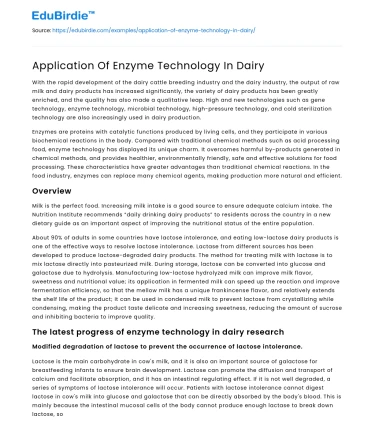With the rapid development of the dairy cattle breeding industry and the dairy industry, the output of raw milk and dairy products has increased significantly, the variety of dairy products has been greatly enriched, and the quality has also made a qualitative leap. High and new technologies such as gene technology, enzyme technology, microbial technology, high-pressure technology, and cold sterilization technology are also increasingly used in dairy production.
Enzymes are proteins with catalytic functions produced by living cells, and they participate in various biochemical reactions in the body. Compared with traditional chemical methods such as acid processing food, enzyme technology has displayed its unique charm. It overcomes harmful by-products generated in chemical methods, and provides healthier, environmentally friendly, safe and effective solutions for food processing. These characteristics have greater advantages than traditional chemical reactions. In the food industry, enzymes can replace many chemical agents, making production more natural and efficient.
Save your time!
We can take care of your essay
- Proper editing and formatting
- Free revision, title page, and bibliography
- Flexible prices and money-back guarantee
Overview
Milk is the perfect food. Increasing milk intake is a good source to ensure adequate calcium intake. The Nutrition Institute recommends “daily drinking dairy products” to residents across the country in a new dietary guide as an important aspect of improving the nutritional status of the entire population.
About 90% of adults in some countries have lactose intolerance, and eating low-lactose dairy products is one of the effective ways to resolve lactose intolerance. Lactase from different sources has been developed to produce lactose-degraded dairy products. The method for treating milk with lactase is to mix lactase directly into pasteurized milk. During storage, lactose can be converted into glucose and galactose due to hydrolysis. Manufacturing low-lactose hydrolyzed milk can improve milk flavor, sweetness and nutritional value; its application in fermented milk can speed up the reaction and improve fermentation efficiency, so that the mellow milk has a unique frankincense flavor, and relatively extends the shelf life of the product; It can be used in condensed milk to prevent lactose from crystallizing while condensing, making the product taste delicate and increasing sweetness, reducing the amount of sucrose and inhibiting bacteria to improve quality.
The latest progress of enzyme technology in dairy research
Modified degradation of lactose to prevent the occurrence of lactose intolerance.
Lactose is the main carbohydrate in cow's milk, and it is also an important source of galactose for breastfeeding infants to ensure brain development. Lactose can promote the diffusion and transport of calcium and facilitate absorption, and it has an intestinal regulating effect. If it is not well degraded, a series of symptoms of lactose intolerance will occur. Patients with lactose intolerance cannot digest lactose in cow's milk into glucose and galactose that can be directly absorbed by the body's blood. This is mainly because the intestinal mucosal cells of the body cannot produce enough lactase to break down lactose, so Lactose intolerance is actually a lactase deficiency. Lactase deficiency is a widespread worldwide problem and is actually more common in Asians and Africans.
Hydrolyzed milk protein to prevent milk allergic reactions.
Milk protein allergy is a very serious problem for some specific groups, especially those with congenital allergies. The clinical symptoms are mainly angioedema, urticaria, atopic dermatitis, respiratory symptoms, acute abdominal pain, diarrhea, vomiting and allergic reactions. Lactin or casein, which is an allergen in some special populations, because of its immunogenic protein, can avoid the immunoglobulins present in intestinal mucosal epithelial cells, and is adsorbed on the intestinal mucosa Produces actions of the immune system. This triggers allergic reactions to cow's milk in some infants and adults, causing symptoms such as rash and asthma.
With the screened protease, the peptides obtained by hydrolysis not only improve its digestibility, but also hydrolyze the fragment with the determinant site of the antigen, which significantly reduces its antigenicity, thereby preventing milk allergy. Compared with the free amino acid mixture, the milk protein enzymatic product has the advantages of good flavor, high absorption rate, and low osmotic pressure. Generally, the method of synergistic effect of enzymatic hydrolysis treatment and heat treatment or ultrafiltration treatment is used to prepare hypoallergenic casein and whey protein hydrolysates. Heat treatment has a slight effect on the immunogenicity of milk proteins, but heat treatment can affect the configuration of milk proteins, increase the chance of proteolytic enzymes contacting the substrate, and obtain hypoallergenic protein hydrolysates.
Milk contains a variety of ingredients with antibacterial activity and has multiple effects.
Such as immunoglobulin, lactoferrin, lactoperoxidase and lysozyme, these components can prevent the occurrence of cow mastitis and inhibit the growth of microorganisms during the storage of raw milk and dairy products, but they are only effective for a certain period of time. Among them, lactoperoxidase is the main substance to prevent microbial contamination. Each lactoperoxidase molecule contains an iron atom. Lactoperoxidase itself has no antibacterial activity and is composed of hydrogen peroxide and thiocyanate. The natural antibacterial system, the so-called lactoperoxidase system, has antibacterial and antiseptic effects. Lactoperoxidase inhibits Gram-negative bacteria (including E. coli and Salmonella strains) and Gram-positive bacteria. Its antibacterial effect is related to 5H value, temperature and bacterial count. The antibacterial properties of the lactoperoxidase system are increasingly used in animal production and clinical medicine. For example, activating raw milk's own lactoperoxidase system can extend its shelf life; adding sodium thiocyanate to raw milk can prevent milk spoilage; adding lactoperoxidase to milk substitutes to replace antibiotics can prevent drug resistance. occur.
Enzyme preparations are becoming more and more widely used in the food industry, especially in the dairy and dairy industries. With the development of new technologies such as genetic engineering, the application potential of enzyme engineering is expected to be further realized. Looking to the future, enzyme preparations, a clean technology derived from nature itself, have broad application prospects in finding innovative, economical and environmentally friendly methods and providing solutions to industrial problems throughout the world.






 Stuck on your essay?
Stuck on your essay?

